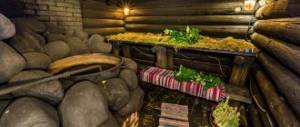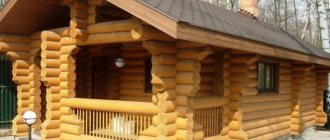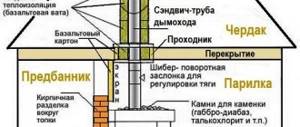We go to the bathhouse not only to take a steam bath, but also to wash ourselves. After the steam room, it’s good to splash yourself with ice water, but you want to wash yourself in hot water. Therefore, it is important to take a hot shower in the bathhouse. In this article we will look at various ways to make it yourself.
[toc]
The easiest way to make a hot shower in a bathhouse is to install a dousing device (bucket) and supply water to it. Such a bucket shower for a bath can be bought in a specialized store. There are models into which water is poured from a regular bucket, and there are those into which water is supplied from a tap. Turning on and off the water supply is controlled by a float (a device similar to that found in waste tanks).
Bucket shower for a bath
Room layout
Finishing the shower room in the bathhouse should begin after planning the room. To do this, it is recommended to draw up a separate drawing of the room, which indicates the location of the washing room elements. Features of drawing up a plan:
- A shower with a mixer should be installed in a place where it is more convenient to supply cold and hot water through the pipeline.
- Along the perimeter of the room, shelves should be fixed on which washcloths, shampoos, and soaps will be placed.
- It is better to leave the central washing area free. This place will be convenient for dousing yourself with cool water after the steam room.
It is necessary to arrange the shower elements so that they do not interfere with movement and water procedures.
Porcelain tiles
The use of a floor covering with a smooth surface is unacceptable where there is high humidity, but structured porcelain stoneware is quite suitable for a bathhouse floor. For walls, you can use porcelain tiles with a glossy surface. A large selection of sizes and textures makes it possible to realize your desires when creating the intended room design.
The undoubted advantage of this facing material is its lowest level of water absorption, therefore, when using frost-resistant glue, porcelain stoneware will withstand large temperature changes and will not collapse.
Design styles
Now a bathhouse is not a modest hut with one large room in which people steam, but a full-fledged complex that has several rooms for different purposes.
When choosing a design style for rooms in a bathhouse, it is recommended to settle on a single option. It will give the room a holistic look. When creating a design, you need to pay attention to a number of factors:
- The classic option for interior cladding of bathhouses is lining made from different types of wood. It is important to choose wood varieties that do not release resins when exposed to high heat.
- It is necessary to allocate places for storing body care products and washcloths. They should be at hand, but not create chaos.
The most popular design styles:
- Modern - a combination of simplicity and elegance. The wooden panels that line the rooms are sanded to such a state that the natural grain of the wood disappears. The equipment inside is modern, without classical elements.
- Chalet style. The interior is dominated by antique decorations. This could be bladed weapons, armor, paintings, figurines, precious stones.
- Classic Russian style. It assumes a wooden finish, which is decorated with hand carvings.
You can combine styles if desired.
How to heat water for a shower in a bathhouse
Heating water with electric water heaters
You can heat water for a shower either using electric heaters - a flow-through or storage water heater, a “wet” heating element, or using a remote tank and a heat exchanger in a wood-burning stove.
A flowing water heater for a shower in a bathhouse is a pleasure that is not available to everyone. And it’s not about the price, but about the requirements that this equipment places on both the water supply and the electrical network. An instantaneous water heater operates at a certain cold water pressure. This problem can be solved by installing a pump (its capacity must be at least 8 liters/min). But in any case, the water will only be heated if electricity is available, and there will be no supply of warm water - this is a running water heater, after all. In addition, only a heater with a power of no more than 8 kW is connected to the 220V network, which will provide warm water to only one water collection point. If you need to have two hot water taps, you will need a device with a power of 13 kW, and it is powered from a 380 V network. Even if you are satisfied with an eight-kilowatt instantaneous water heater for a shower, then when you turn it on, there will most likely be a significant drop in the voltage in the network: in suburban networks this is not uncommon, but the neighbors are unlikely to be happy with such a turn.
Water heater for shower. Connection diagram
Storage water heaters for showers are more economical. The power they consume is usually 2-3 kW, depending on the volume of the drive, but it is difficult to find a capacity of more than 150 liters. Moreover, such a tank is already of decent size, although there are storage tanks of different shapes - horizontal and vertical cylinders, there are also rectangular ones - it’s easier to find a place for them, but you still have to worry about installing it. A good option is to install a heater in the attic.
There is another simple way to organize hot water in a bathhouse: a heating element is installed in the water tank; in the simplest case, a boiler is lowered. There is an outlet from the tank either to the mixer or directly to the shower head with a tap or mixer. When directly connecting a warm water tank to a shower head, you need to consider a temperature control system so as not to get burned by overly hot water.
These are, in general, all the options for an “electric” shower for a bath. Read more about how to choose a water heater for a bath here.
Important! When using electric heating elements, never forget about electrical safety. Even a new heating element or boiler can “punch” into the body.
Heating water from the stove
There is also a typical “bath” method: heat water in a tank using heat from a burning stove. There is a method from previous years - wood-burning titanium, which, nevertheless, is successfully used today. Here is an effective, working, real way to organize a shower in a bathhouse without using electricity.
Scheme of arranging a shower in a bathhouse or sauna
This scheme, with some modifications, will work when using a remote water tank, the water in which is heated from a heat exchanger in a metal or brick oven, and with a tank on a pipe (installed at a sufficient height). In general, the scheme is good. Instead of a hand pump, you can install an electric one, but then the circuit will only work if there is a power supply.
We have chosen a way to heat the water, but now we need cold and hot water to be supplied to the mixers. If the hot water tank is not high, pumps are provided in the system to increase the water pressure to ensure the required pressure. Shower pumps can be of several types:
- Small pumping stations are a more expensive option. But they have automatic protection that will monitor the pressure in the system (it will turn off if there is a problem in the electrical network, etc.).
- Boost pumps. They also turn on automatically when the pressure in the system decreases, but the type of pump and its characteristics must be selected separately for each water supply system. Their disadvantage is that if there is no pressure accumulator in the system, when the pump is turned on/off, the water pressure noticeably “jumps”.
- Garden pumps. The cheapest option, but they do not have any automation, therefore, you need to turn them on/off manually.
If possible, it is easier to install a tank for cold and hot water in the bathhouse on the second floor or in the attic and not bother with pumps, which are not at all easy to select for hot water.
Option to install a water tank at a height higher than the ceiling height
Wall decoration
There are many known materials that can be used to cover shower walls. Each of them has certain characteristics, strengths, and weaknesses.
Material selection
The choice of material for finishing the walls in the washing bath depends on the style of the room:
- Traditional Russian style - timber, lining.
- Modern loft - brick, ceramic tiles. Communication must be open to match the style.
- Mediterranean style - a combination of ceramic tiles with natural stone.
- Roman style - a variety of mosaics that decorate columns.
Wood
More often, steam rooms and showers are lined with wooden clapboards. Advantages:
- installation work can be performed by a person even without practical skills;
- attractive appearance;
- resistance to mechanical damage.
Flaws:
- Some types of wood release resin when heated strongly.
- If the lining is not impregnated with a special antiseptic composition, it will gradually become covered with mold and mildew.
The main advantage of wood is that it does not emit harmful substances when heated strongly.
Ceramic tile
For steam rooms, ceramic tiles cannot be used as a finishing material. It becomes very hot and can cause serious burns. At the same time, ceramics are suitable for showers. Advantages:
- durability, high strength;
- easy cleaning of the surface from dirt and dust;
- high resistance to mechanical damage;
- resistance to various chemicals.
Ceramic tiles have no serious disadvantages.
Natural stone
Using natural minerals, you can create a unique natural design that will appeal to many bathhouse attendants. For interior decoration of bathhouses, different types of stones are used - travertine, granite, marble, sandstone, quartz.
Advantages:
- attractive appearance;
- durability, reliability, resistance to damage.
Natural minerals are not suitable for cladding walls inside steam rooms. The stones become very hot and touching them can cause serious burns. In addition, minerals weigh a lot and require the use of additional fasteners.
Plastic panels
Plastic is a popular material for finishing bathtubs and showers. PVC panels can be purchased at a hardware store. Advantages:
- fungus and mold do not form on the plates;
- plastic is durable and does not deteriorate from water;
- the material does not emit harmful substances to the body;
- You can find different types of slabs in stores.
Disadvantages include the low resistance of plastic to strong heat, a gradual change in appearance with prolonged exposure to high temperatures.
Painting
The inside of the shower room can be painted. In this case, you need to assemble a frame from waterproof plasterboard on top of the walls. To build the frame, you need metal guides and connecting jumpers. The paint must withstand constant humidity and high temperatures without deteriorating.
Carrying out work
Finishing work depends on the selected material. Features of working with different facing materials:
- The lining is nailed on top of the wooden walls using finishing nails. You need to nail the vapor barrier film onto the wall using wooden slats. The lining is stuffed on top. It is important not to drive the tenon completely into the groove. You need to leave a little space so that the tree can contract and expand during changes in temperature and humidity.
- Ceramic tiles and decorative stone are fixed with special masonry mortars.
- To secure plastic boards to vertical walls, you need to use metal or wood screws.
Construction of a bathhouse frame from timber
When building a timber frame, you must carefully select the material. Raw timber will be much cheaper, however, the start of construction will have to be postponed until the material has completely dried for at least a year. Dry timber is much more expensive. After delivery of the material, you can immediately begin building a bathhouse with a shower.
When building a wooden bathhouse with a shower in the country, you should give preference to hardwood: aspen, oak, larch, pine, spruce.
To build the frame, you will need timber with a diameter of 200 mm. The frame elements are fastened together using anchor bolts and building angles. The frame is covered with several layers of antiseptic.
You can watch the video in more detail about all the stages of constructing a frame for a bathhouse:
Floor and ceiling finishing
After choosing the facing material for the shower walls, you can begin finishing the ceiling and floor. Features of the work:
- For the floor, it is better to choose wood or tiles. A wooden floor does not require additional insulation, but it is less durable than a tiled floor. The tile freezes quickly. To correct this drawback, it is recommended to install a “warm floor” system.
- For ceilings it is better to choose wooden lining. This material weighs less than tiles and is more durable than waterproof drywall.
Before finishing the walls and ceiling, you need to think about the location of the light sources. If you think about it later, you will have to spoil the finishing materials.
Salt tile
Let's start with the fact that salt tiles for a bath are an environmentally friendly, natural material. It may seem that such translucent blocks of Himalayan salt can crumble even from a small impact, but this is not the case.
In fact, having a healing and health-improving effect, salt bath tiles are used quite often because they are beautiful and very durable.
Application area
Since this finishing material is not cheap, only wealthy people can purchase it to decorate the entire bathhouse. Most often, partitions are made from salt blocks or walls are decorated with them. Since the material is translucent, LED lighting is often mounted behind it.
note
Since it is still salt, constant exposure to water will not have the best effect on the condition of the finishing material, so using it in a steam room is not advisable. More acceptable conditions are in the Finnish sauna, since the humidity in it is low.
Salt blocks are suitable for decorating or finishing the stove, walls and ceiling, and can be used as floor tiles for a bath, but only if the room is well ventilated. The following compounds are used to fix blocks:
- Two-component adhesive based on caustic magnesite.
- A mixture of magnesite and magnesium chloride.
- Liquid glass (silicate glue).
- Special glue for Himalayan salt.
It is preferable to use the latter preparation, since in this case the seams will not stand out against the general background.
Ventilation
Before you start using any bathhouse, you need to take care of a high-quality ventilation system. There are two types of similar systems that are relevant for wooden showers:
- Natural - two windows located at different heights. Through one, the flow of fresh air enters the room, through the other it is discharged outside.
- Forced - the design resembles a natural system, but a fan is installed at the exhaust vent, which speeds up the process of air circulation in the room.
The second ventilation option is suitable for large showers. The first is sufficient for small buildings.
Communications
Particular attention should be paid to communications. Thick, moist steam is a good conductor of electricity. Therefore, switches, panels, sockets should be installed inside the dressing room, and not in the shower or steam room. When choosing lamps, it is better to give preference to devices with ceramic sockets and wooden lampshades.
If we talk about drain pipes, they should be installed inside the floor during the first stages of construction. The drains are discharged into a special well, which consists of separate concrete rings.
Choosing a shower stall
To choose a shower stall for a bath, you need to listen to the opinions of experienced bathhouse attendants:
- If the shower stall only needs washing, it is enough to install the simplest open model.
- If there is enough space in the washing room, it is better to take a shower stall model with swinging doors.
- For small rooms, it is better to purchase a design with doors that slide together.
- If after visiting the steam room you want to relax under streams of warm water, it is better to choose closed-type structures.
Furniture selection
Standard equipment for shower bath furniture:
- shelves for storing washcloths, shampoos, shower gels;
- a barrel of cold water;
- sink, mirror;
- shower;
- shop.
Can be supplemented with buckets, ladles, moisture-absorbing mats or rubber plates on the floor to prevent the tiles from slipping.
Options from the store
You can buy bath furniture in specialized stores. Benches and water barrels are made of oak, ash, birch, maple, and linden. Ready-made furniture is more expensive than homemade furniture.
Making furniture yourself
To make a bench for a bathhouse with your own hands, you need to prepare bars and linden boards. Additionally, you will need self-tapping screws, a hand or electric saw, and a screwdriver. Build process:
- The side parts on which the bench will be supported are rectangles with legs.
- After assembling the side parts, you need to connect them together with a long transverse board.
- Place 3 boards 10–15 cm wide on top of the two parts.
Professionals answer questions
Often, people who want to do repairs themselves have questions that cannot always be answered. At our request, the professionals provide an explanation.
Is it possible to glue tiles onto a rotband?
The tiles adhere perfectly to this leveling mixture. When the surface is too smooth, adhesion can be improved by notching the wall. If the wall is leveled immediately before installing the tiles, then you need to take into account how long it takes for the rotband to dry under the tiles.
How to plaster foam blocks inside a bathhouse so that the tiles stick?
Let's start with the fact that it is not at all necessary to plaster a wall made of foam blocks. When the surface is flat, it is enough to prime it thoroughly, and after drying, glue the tiles. If the wall is uneven, then it can be plastered with gypsum plaster, with a layer of at least 10 mm.
How to glue tiles in a foam block bath?
If the bathhouse is built from GGP (gypsum blocks), then preference is given to gypsum-based assembly adhesive. When gluing to foam or gas blocks, a cement-based composition is used.
Are there truly non-slip tiles?
There are bath floor tiles on sale, equipped with a special system called “Anti Slip”. These floor tiles are completely safe. Even before firing, a thin layer of a special composition with minerals is applied to the glaze. During firing, they change the properties of the glaze, resulting in a relief texture.
Combination of steam room and washing room
If there is a lot of space in the bathhouse, you can combine a steam room with a washing room. To do this, the room must be delimited with special glass doors that are installed on guides. This way you can combine both rooms into one or make a distinction during the bath procedures.
The shower room in the bathhouse is a special room in which people wash themselves of sweat, dirt, and leaves after visiting the steam room. Its interior design and arrangement raises many questions among novice bathhouse attendants who have recently built a bathhouse. To make your shower unique, you can come up with a custom design.
Choosing the type of foundation
A bathhouse with a shower in the country is a lightweight object and allows the construction of one of the following types of foundation:
- strip shallow foundation;
- pile-screw;
- columnar.
You can do without a foundation at all; this option is suitable for building or purchasing a mobile bathhouse with a shower for your country house.
The construction of a mobile bathhouse differs from the traditional version in the absence of a foundation. This design is installed on a car trailer and can be easily moved if necessary. Inside the mobile bathhouse it is easy to organize a shower, steam room and a small relaxation room.











